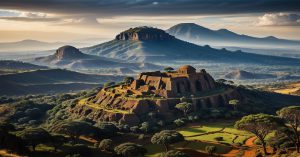Spiritual Sojourns: How Religious Tourism Shapes Our World
Religious tourism, also known as faith tourism, is a type of tourism where people travel individually or in groups for pilgrimage, missionary, or leisure purposes.
Some of the popular religious tourism destinations includes; Mecca, Saudi Arabia, The Wailing Wall, Jerusalem-Israel, Senso-Ji Temple and Meiji Shrine, Tokyo-Japan, Vatican City, Italy and Basilica Of Our Lady Of Guadalupe, Mexico City-Mexico.
The world’s largest form of mass religious tourism takes place at the annual Hajj pilgrimage in Mecca, Saudi Arabia. North American tourists, for instance, travel to religious landmarks in Southern American countries like Mexico, which is home to a multitude of historic churches and religious sites.
Religious tourism holds a profound significance in shaping both individual experiences and global cultural landscapes. These sacred travels have transcended mere vacations, evolving into transformative quests that impact societies, economies, and spiritual beliefs worldwide. Let’s delve into the intricate tapestry of religious tourism and explore its multifaceted influence on our world.
Understanding the Essence of Religious Tourism
At its core, religious tourism encompasses journeys undertaken for spiritual enrichment and cultural immersion. Individuals embark on these pilgrimages to connect with divine entities, seek enlightenment, or fulfill religious obligations. These travels often involve visits to sacred sites, shrines, temples, churches, mosques, or other religious landmarks of historical and cultural significance.
The Pull of Pilgrimage
Pilgrimage, a central aspect of religious tourism, holds a timeless allure for believers across diverse faith traditions. It offers a tangible manifestation of devotion, providing pilgrims with a sense of purpose, renewal, and transcendence. Whether it’s the Hajj to Mecca for Muslims, the Kumbh Mela for Hindus, or the Camino de Santiago for Christians, these journeys symbolize a profound spiritual commitment and communal solidarity.
Cultural Exchange, Understanding and Preservation.
Beyond its spiritual dimensions, religious tourism fosters cross-cultural dialogue and understanding. Pilgrims encounter diverse customs, traditions, and rituals, enriching their perspectives and deepening interfaith connections. This cultural exchange promotes tolerance, respect, and appreciation for religious diversity, nurturing a more inclusive and harmonious global society.
Religious tourism plays a crucial role in cultural preservation. It encourages the maintenance and restoration of ancient churches, temples, mosques, and other religious sites. These sites are not just places of worship, but also repositories of history, art, and culture. By visiting these sites, tourists contribute to the preservation and appreciation of these cultural treasures.
The Spiritual Journey
A religious journey can be a deeply personal and transformative experience. It provides an opportunity for self-reflection, prayer, and connection with the divine. For many, it’s a chance to step away from the daily grind and focus on spiritual growth and personal development.
The Economic Impact of Religious Tourism
Apart from its spiritual and cultural significance, religious tourism constitutes a formidable economic force with far-reaching implications. The influx of pilgrims and tourists sustains local economies, spurring infrastructure development, job creation, and revenue generation.
Boosting Local Economies
Sacred sites and pilgrimage destinations often serve as economic engines for surrounding communities. They attract tourists, pilgrims, and religious scholars, stimulating demand for accommodation, transportation, food, souvenirs, and other goods and services. This influx of visitors revitalizes local businesses and supports livelihoods, contributing to economic growth and prosperity.
Infrastructure Development
The surge in religious tourism necessitates infrastructure enhancements to accommodate the needs of pilgrims and tourists. Governments and private stakeholders invest in transportation networks, hospitality facilities, sanitation systems, and security measures to ensure a safe and seamless pilgrimage experience. These developments not only benefit pilgrims but also enhance the overall tourism infrastructure, attracting secular tourists and fostering sustainable growth.
Environmental and Social Impacts
While religious tourism brings about numerous benefits, it also poses environmental and social challenges that warrant careful consideration and mitigation strategies.
Environmental Conservation
The preservation of natural and cultural heritage is imperative in safeguarding sacred sites and maintaining their spiritual integrity. Sustainable tourism practices, such as waste management, energy conservation, and biodiversity preservation, are essential to mitigate the environmental footprint of pilgrimage activities. Collaboration between stakeholders, including religious authorities, governments, and local communities, is crucial in promoting responsible tourism and protecting fragile ecosystems.
Social Harmony and Inclusivity
Religious tourism has the potential to promote social cohesion and harmony by fostering interfaith dialogue and cooperation. However, it also has the propensity to exacerbate tensions and conflicts, particularly in regions marked by religious or ethnic strife. Promoting inclusivity, tolerance, and mutual respect is essential in mitigating sectarian divisions and promoting peaceful coexistence among pilgrims and host communities.
Conclusion: Navigating the Path Ahead
In conclusion, religious tourism exerts a profound influence on our world, shaping spiritual beliefs, cultural identities, and economic landscapes. As we navigate the complexities of this phenomenon, it is imperative to strike a balance between spiritual reverence, economic prosperity, and environmental stewardship. By embracing sustainable practices, fostering interfaith dialogue, and promoting social inclusivity, we can harness the transformative power of religious tourism to build a more equitable, peaceful, and interconnected global community.




